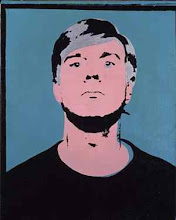 |
| Ellsworth Kelly, Train Landscape, 1952-3 |
In both reproduction and literal description Ellsworth Kelly's Modernist abstractions can seem banal; however, this belies the grand, voluptuous physical presence of these majestic paintings experienced in a gallery.
The often subtly shaped canvases (frequently curved), the precisely scaled, toned and juxtaposed expanses of pure colour achieve a rare spiritual and sensual effect that is unique to this artist. Indeed, it is difficult to locate Kelly tidily amongst his forbears and peers: his work is more cool and subtle that most of the Abstract Expressionists, more sensual and spiritual than the Post-Painterly Abstractionists such as Stella and Noland, and more expressive than the Minimalists. Mark Rosenthal aptly describes Kelly's work as exuding "an ineluctable presence, an aura of something palpable" and traces his aesthetic to the artist's interest in Romanesque and Gothic architecture, to Egyptian pyramids and Sung vases as well as to the Modernism of Mondrian and Brancusi; Kelly also collected archaic stone objects for what he termed their "aura of shape". (1)
Alongside his bold, simple colour abstractions Kelly throughout his life drew from nature - his spare outline drawings of plants contributing to the shapes of his paintings. But it will be for the potent distillation of colour that Kelly is remembered as a major post-war American painter.
Read a recent interview with the 92 year old Kelly by Jason Farago.
Read obituaries by Christopher Masters, Holland Cotter, and in The Telegraph
(1) Waldman, D. ed. (1997) Ellsworth Kelly: A Retrospective, London: Tate Gallery, pp62-3
Click on images to enlarge
 |
| Ellsworth Kelly, Window, Museum of Modern Art, Paris, 1949 |
 |
| Ellsworth Kelly, Painting for a White Wall, 1952 |
 |
| Ellsworth Kelly, Rebound, 1959 |
 |
| Ellsworth Kelly, Orange Red Relief, 19596 |
 |
| Ellsworth Kelly, Gate, 1959 |
 |
| Ellsworth Kelly, Red Blue Green, 1963 |
 |
| Ellsworth Kelly, Orange Green, 1964 |
 |
| Ellsworth Kelly, Yellow Piece, 1966 |
 |
| Ellsworth Kelly, Dark Blue Curve, 1995 |
 |
| Ellsworth Kelly, Four Sunflowers, 1957 |
























